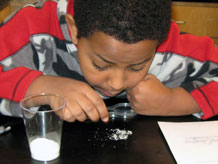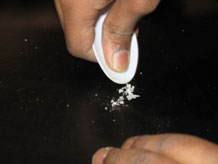What changes and what stays the same when salt dissolves in water?
2. Explore
Before dissolving salt, students will spend a few minutes exploring it.
Note: Allow no more than 2 minutes for each of the explorations in this section.
Closely observe salt

Distribute the first set of materials.
Have each student take a small pinch of salt from the cup, place it on the desk, and examine the grains with a magnifier. Encourage students to look for the tiniest grains they can find in their pinch of salt.
What do you see?
- differences in particle size; some much smaller than others
If students have closely observed table salt, they will notice that kosher salt does not have the same cubic form as table salt.
Transformation by crushing

Demonstrate how to crush salt with the bowl of the plastic spoon without snapping the spoon, by pressing with a finger in the bowl of the spoon.
Have students crush the salt on their desks and inspect it again using their magnifiers. Ask students to look for the smallest pieces of salt they can find.
What changes and what stays the same when you crush salt?
- Particle size has decreased; some are very tiny.
- The number of particles has increased.
- The tiny pieces are still salt.
- The total amount of salt remains the same.
Do you think each grain of salt has weight? Even the tiniest pieces?
- Yes
How would you convince someone that a grain of salt has weight? How could you prove it?
- See the introduction to this session for a possible argument.
Do you think salt is matter? Why?
- Salt is matter because it has weight and takes up space.



